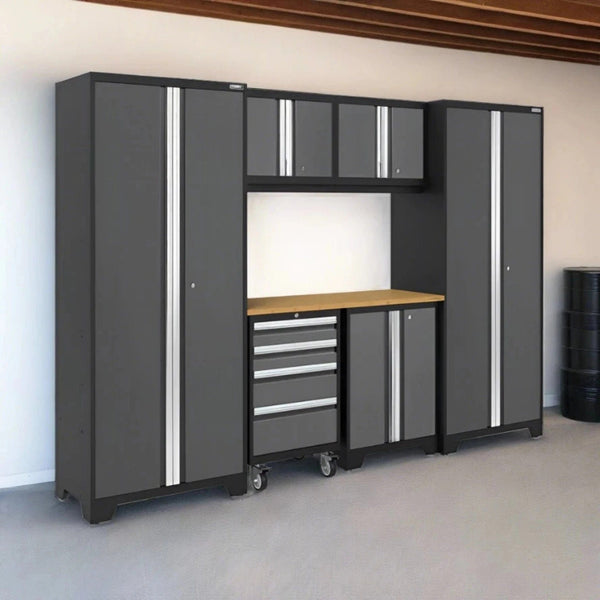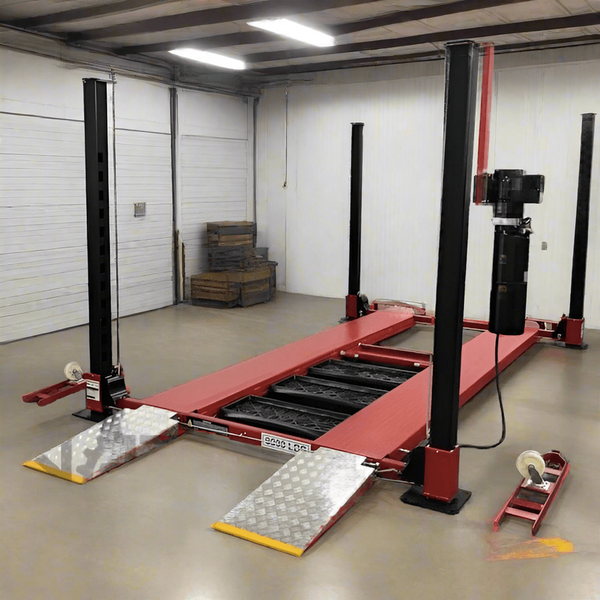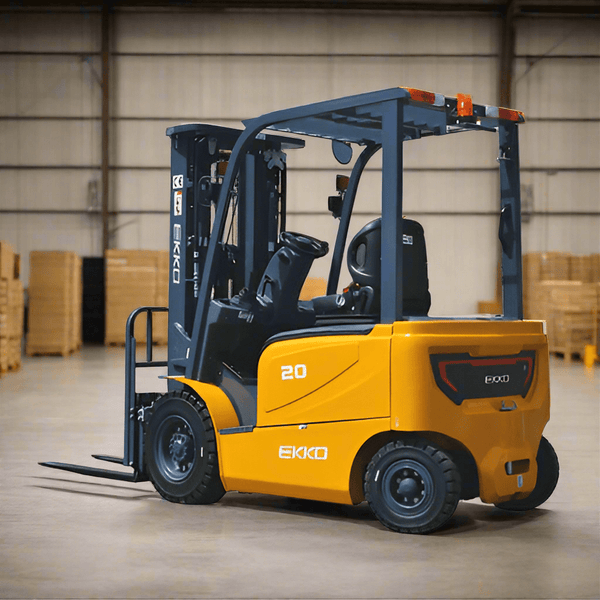
2-Post vs 4-Post Lift: Which is Better for Your Garage?
From home garages to professional auto repair shops, car lifts are essential for both servicing and storing vehicles. But with so many options available, it’s hard to narrow it down. We recommend starting by choosing between a 2-post vs 4-post lift.
Our 2-post car lift collection is great for gaining full access to wheels and underbody for routine service. They tend to be more affordable and the go-to choice for mechanics, but they do require thicker concrete and have other installation complexities. They’re less stable, too.
On the other hand, our 4-car post lift selection helps facilitate better storage of vehicles when not in use. They’re easier to drive onto and operate, too, and can be moved with caster kits. But they take up a lot of space, provide limited underbody access without jacks, and cost more.
Ultimately the decision between a 4-post vs 2-post lift comes down to your garage dimensions and layout, your goals for the lift, and your budget. This is something we can help you navigate one-on-one as the #1 choice for a car lift online.
Get in touch with My Garage Supplies today for a personalized recommendation. Or, learn more about the nuances between a two-post vs four-post car lift below!
| Feature | 2-Post Lift | 4-Post Lift |
|---|---|---|
| Lifting Method | By the frame using swing arms | By the tires on drive-on runways |
| Undercarriage Access | Full access to wheels and underbody | Limited without optional jack trays |
| Footprint + Height Clearance | Smaller footprint; needs 10–12 ft ceilings | Larger footprint; may work with lower ceilings |
| Installation + Power | Anchored install; 220V required | Often freestanding; 110V or 220V |
| Portability | Fixed in place once installed | Many models movable with caster kit |
| Ease of Use | Requires careful positioning under lift points | Drive-on design; easier for casual users |
| Use Case | Best for active service, frequent repairs | Best for storage, stacking, light maintenance |
| Cost | Generally more affordable | Typically higher upfront cost |
Overview of 2-Post Lifts
Pros:
- Full access to wheels and undercarriage
- Smaller footprint compared to 4-post lifts
- Ideal for garages focused on frequent repair or service
- Typically lower cost than 4-post systems
Cons:
- Requires a thick, reinforced concrete slab
- Installation is more involved
- Less stable for long-term vehicle storage
- Harder to drive onto and position compared to 4-post lifts
As the name suggests, a 2-post lift uses two upright columns and a set of swing arms to lift a vehicle by its frame or designated lift points. You get complete access to the wheels, suspension, underbody, and drivetrain, so these are preferred for repairs and inspections.
The lift raises the vehicle between the posts, suspending it in the air with minimal ground obstruction. Technicians are then free to work efficiently underneath the vehicle with no obstructions.
There are two main types of 2-post lifts: symmetric and asymmetric. Symmetric models center the vehicle between the columns and use equal-length arms. They’re best for large, heavy vehicles.
In contrast, asymmetric lifts offset the vehicle toward the rear with unequal arm lengths and rotated columns for better door clearance and is a better fit for cars and compact SUVs. That said, let’s look at the other half of the 2-post vs 4-post lift comparison below.
Overview of 4-Post Lifts
Pros:
- Easier to load and operate, especially for non-professionals
- More stable for storage and longer-term parking
- Can often be moved with caster kits
- No need to locate lift points under the vehicle
Cons:
- Larger overall footprint
- Higher upfront cost
- Limited underbody access unless used with rolling jacks
- Not ideal for frequent suspension, brake, or wheel service
A 4-post lift supports the vehicle by its wheels using four vertical columns and two long runways. You simply drive up onto the lift and then can raise it while it sits on its tires, rather than being lifted by the frame.
This makes for a much more stable structure which is why 4-posts are utilized for vehicle storage, car stacking, and light maintenance work like oil changes or exhaust work.
This is also why four-post lifts are easier to operate, especially for users who aren’t lifting vehicles every day. Some models are equipped with built-in casters, jack trays, and drip trays, perfect for multi-purpose garage setups.
Just know these will require a lot more space than their 2-lift counterparts, so even if you prefer this style, it may not be feasible in your specific garage. That said, let’s compare and contrast the 2-post vs 4-post lift side by side below to help you make the right decision.
2-Post vs 4-Post Lift: Which is Right For Your Garage?
Be clear - both the 2-post and 4-post lift have their places in garages across the nation. You may even find some shops have both options since each works best in different situations.
That said, you’re probably only interested in choosing one or the other, and we’re here to help you feel confident making that decision with a thorough comparison of the two-post vs four-post lift below.
Garage Size and Ceiling Height
The specific space you plan to install your lift in is the biggest limiting factor, so we recommend starting here as you narrow it down between a 2-post vs 4-post lift.
The smaller footprint of a 2-post lift makes it a better fit for tighter garages. But you'll need at least 10-12 feet of ceiling height to raise most cars fully since it lifts the vehicle by the frame.
Some asymmetric models give you more side clearance for opening doors in smaller garages, but you’ll still need adequate overhead space to work safely.
In contrast, 4-post lifts typically take up more width and depth because of the runway structure. They usually need less ceiling clearance for basic operation, though, since they raise the vehicle on its wheels rather than the frae.
That means 4-post lifts are a great fit for standard residential garages, especially when your primary use case is tacking cars or parking instead of full-service repairs.
Vehicle Type and Weight
The cars you anticipate lifting matter as well. A 2-post lift suspends the vehicle by frame contact points so weight distribution and center of gravity need to be taken into account.
You’ll need a 2-post lift with 10,000+ lbs of capacity and arms long enough to safely reach factory lift points for heavy-duty trucks, vans, or lifted vehicles. You’ll also want to factor in concrete thickness to confirm it can support the install.
A 4-post lift supports the vehicle at the tires and doesn’t rely on balance or arm positioning, meaning it’s a more forgiving option for longer or heavier vehicles when storage or general access is the goal. You can use jack trays to lift one end of the vehicle off the runway for light repairs if need be.
Maintenance vs Storage
You may be starting to pick up on this already, but one of the biggest differences between a two-post vs four-post lift comes down to what you plan on using it for - maintenance vs storage.
Changing brakes, dropping a transmission, or doing suspension jobs all call for the unobstructed access that only a 2-post lift can provide. You can effortlessly reach the wheels and underbody.
On the other hand, a 4-post lift is far more practical if you want to store an extra car inside or keep a seasonal vehicle safe and out of the way. It’s drive-on ready, doesn’t require perfect arm positioning, and is stable enough for long-term storage with minimal daily use.
Now, you could make the case that the four-post lift is a bit more versatile since you can store vehicles on it and do some level of maintenance - but the obstructed access means you’ll have to jump through more hoops to get to the wheels or the undercarriage with jacks.
Like we said earlier, there’s also plenty of shops around the world that have both styles in their facility since they serve somewhat different purposes. But if you can only justify one or the other, think carefully about what matters most to you.
Installation and Portability
2-post lifts are permanently anchored into the concrete and almost always require professional installation. Precise measurements and verified slab strength are of the utmost importance.
In other words, they’re not easy to move once you have yours anchored in place. That might not matter to you, but if it does, a 4-post lift makes more sense. These come with caster kits so you can move them around your garage when needed.
Budget and Power Requirements
You shouldn’t make this decision based on cost alone as performance and reliability is what matters most in choosing a car lift. However, 2-post lifts generally cost less upfront than 4-post systems, especially in looking at similar capacity ratings.
But it’s also important to note that 2-post lifts almost always require a 220V dedicated power line, while some 4-post lifts run on standard 110V. This means you need to look beyond the sticker price and ask yourself:
- Will you need to hire an electrician?
- Does your concrete meet the slab depth and PSI requirements?
- Do you need accessories like jack trays, drip trays, or rolling jacks?
The total cost of ownership may even out depending on how much electrical and structural prep your garage needs. Run the numbers and see which makes more sense.
So, Which is Better: 2-Post or 4-Post Lift?
You should feel confident about which is best for you between the 2-post vs 4-post lift at this point. They more or less serve different purposes:
- A 2-post lift gives you more flexibility for repairs if you’re doing frequent mechanical work and have the overhead clearance and floor strength.
- A 4-post lift is the better investment if you need storage, ease of use, or vehicle stacking, even if it costs more and takes up more space.
Still unsure? Measure your garage, look at your vehicle lineup, and get more specific about why you want a car lift in the first place. Then talk to a product expert who can walk you through the trade-offs at My Garage Supplies.
My Garage Supplies Has the Best 2-Post or 4-Post Lifts From Trusted Brands at Unbeatable Prices!
We’re your one-stop shop for high-quality car lifts built for real garages, whether you’re wrenching on vehicles every day or simply trying to make better use of your space.
We carry both 2-post and 4-post lifts from trusted manufacturers like Katool, AMGO, and Triumph, all vetted and handpicked for durability, performance, and safety. You can shop with peace of mind knowing that no matter what lift you buy, you’re getting top-tier value.
We know you came here for help choosing between a 2-post vs 4-post lift, but we also have a single post car lift collection and plenty of car scissor lifts as well.
Our team works directly with residential garage owners and commercial shop managers to help match the right lift to your space, vehicles, and budget. We don’t push what’s expensive - we recommend what’s appropriate.
So, get in touch today and we’ll help you find the perfect solution for your garage!
Bringing Our 4-Post vs 2-Post Lift Comparison to a Close
Choosing between a 2-post and 4-post lift isn’t about which one is “better.” Rather, you need to consider which fits your space, your vehicles, and your goals. In this sense, only you can decide whether a 4-post vs 2-post lift makes sense for your garage.
However, we can definitely help you arrive at the right conclusion. Reach out to our team now and we’ll ask you a few questions. From there, we’ll provide you with a few tailored recommendations and help you weigh your options.
Skip the trial-and-error. Get a lift that fits your garage and does exactly what you need with My Garage Supplies today!



